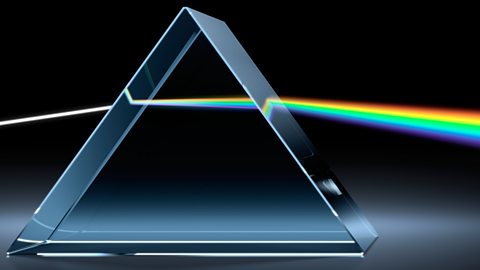What are the key learning points about lenses?
The difference between converging and diverging lenses.
How to draw a lens diagram.
The application of lenses.
Identifying defects of vision and how they are corrected using lenses.
What are the different types of lenses?
When light moves from air into glass or plastic it is refractionProcess by which a wave changes speed and sometimes direction upon entering a denser or less dense medium, eg a light ray changes direction when refracted by a lens., that is it changes direction due to the change in density.
Lenses are used in cameras, telescopes, binoculars, microscopes and corrective glasses.
A lens can be converging (convex) or diverging (concave).
What are converging (or convex) lenses?
A converging lens is thicker in the middle than it is at the edges.
Parallel light rays that enter the lens convergeMove towards each other..
They come together at a point on the principal axisAn imaginary line which runs through the centre of a lens. called the principal focus F, (or focal point).
The centre of the lens is called the optical centre C.
In a ray diagram, a converging lens is drawn as a vertical line with outward facing arrows to indicate the shape of the lens.
Key point
The focal length f of a converging lens is defined as the distance between the optical centre, C, and the principal focus, F.
Focal length is measured in m, cm or mm.
How to measure the focal length of a converging lens.
Point the lens at a distance object outside the window – for instance a tree or building. The greater the distance, the better. Rays of light from this object are taken to be parallel as the object is assumed to be at infinity.
Move the position of the screen behind the lens until a sharp image is formed on it.
Parallel rays of light form an image at the principal focus of a lens, and so the screen is at the principal focus. The distance between the optical centre of the lens and the screen is the focal length, f.
Measure this distance with a 30 cm rule and record in a suitable table.
Repeat the process several times and calculate the average focal length.
What are diverging (or concave) lenses?
A diverging lens is thinner in the middle than it is at the edges.
This causes parallel rays to diverge.
They separate but appear to come from a principal focus F on the other side of the lens.
In a ray diagram, a diverging lens is drawn as a vertical line with inward facing arrows to indicate the shape of the lens.
What are real and virtual images?
The images formed by a lens can be:
upright or inverted (upside down compared to the object);
enlarged or diminished (smaller than the object);
real or virtual.
A real image is an image that can be projected onto a screen.
Rays of light actually pass through the image.
A virtual image cannot be projected onto a screen.
It appears to come from behind the lens and can only be seen by looking through the lens.
Rays of light appear to come from a virtual image, rather than pass through it.
Convex lenses
The type of image formed by a convex lens depends on the lens used and the distance from the object to the lens.
How to draw a lens ray diagram

Image caption, 1. This is how to draw a lens ray diagram.
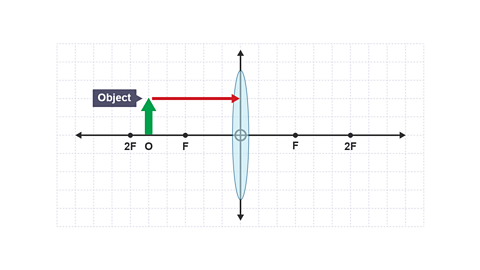
Image caption, 2. Draw a ray from the top of the object to the lens that is parallel to the principal axis.

Image caption, 3. Once through the lens, the ray passes through the principal focus F.
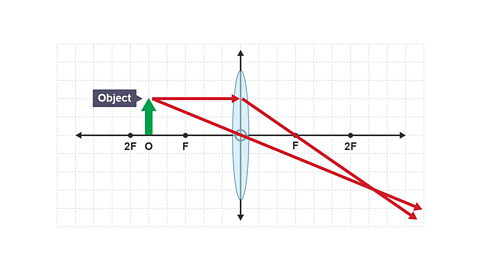
Image caption, 4. Draw another ray which passes from the top of the object through the optical centre of the lens. It passes straight through without being refracted.
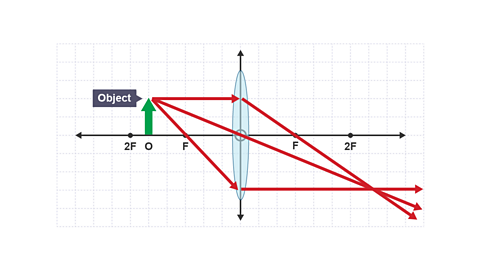
Image caption, 5. A third ray can be drawn from the top of the object through F on the same side of the lens, and then to the lens. Once through the lens, the ray passes parallel to the principal axis.
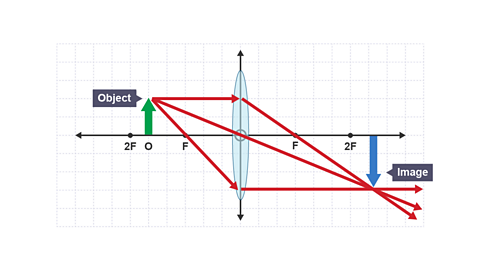
Image caption, 6. The top of the image is where these rays meet. Notice in this case, the image is real, inverted and magnified.
1 of 6
What is the magnification of a lens?
The magnification of lens is defined as the of the height of the image to the height of the object.
M = Hᵢ / Hₒ
A magnification value greater than 1 means the image is enlarged.
A magnification value less than 1 means the image is diminished.
What type of lens is in a camera or the human eye?
Cameras and eyes contain convex lenses.
For a distant object that is placed more than twice the focal length from the lens, the image is:
between F and 2F on the opposite side of the lens to the object;
inverted;
diminished;
real.
Projector
Projectors contain convex lenses.
For an object placed between one and two focal lengths from the lens, the image is:
further away than 2F on the opposite side of the lens to the object;
inverted;
enlarged;
real.
In a film or data projector, this image is formed on a screen.
Film must be loaded into the projector upside down so the projected image is the right way up.
How do magnifying glasses work? (Higher tier only)
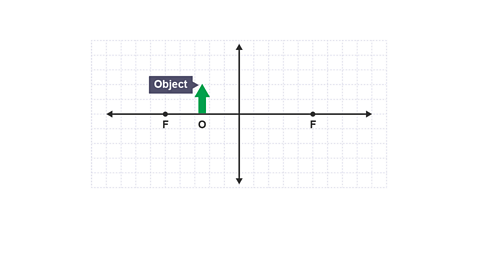
Image caption, 1. A magnifying glass is a convex lens used to make an object appear much larger than it actually is. This works when the object is placed at a distance from the lens of less than one focal length.

Image caption, 2. Draw a ray of light from the top of the object, parallel to the principal axis, to the lens.
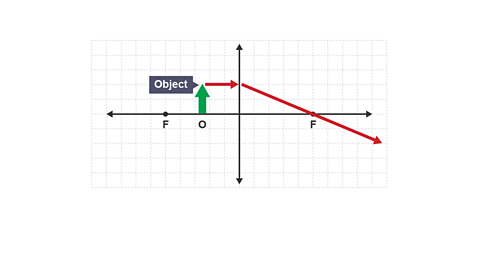
Image caption, 3. Draw this ray refracted through the principal focus.
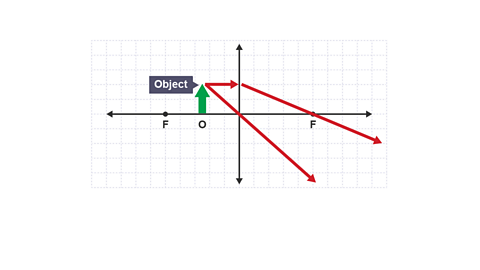
Image caption, 4. Draw another ray from the top of the object straight through the optical centre. Notice that these two rays diverge and will never meet on the right-hand side of the lens.
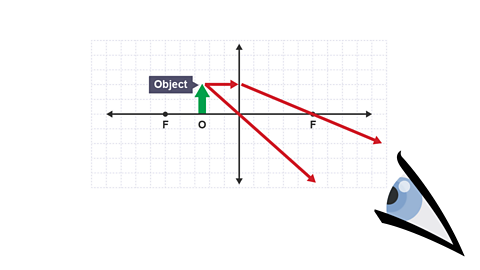
Image caption, 5. To locate the image, we must look through the lens.
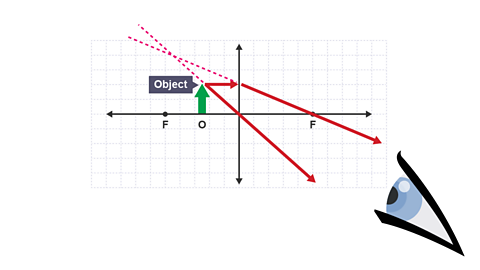
Image caption, 6. As light travels in straight lines, these virtual rays appear to come from a different location. Virtual rays as always dashed and never have an arrow.
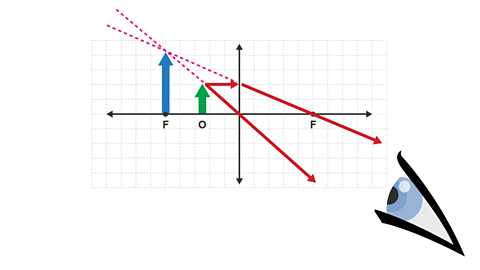
Image caption, 7. The top of the image is where these two virtual rays meet. Notice the image is upright, magnified and virtual. It is on the same side of the lens as the object, but behind the object.
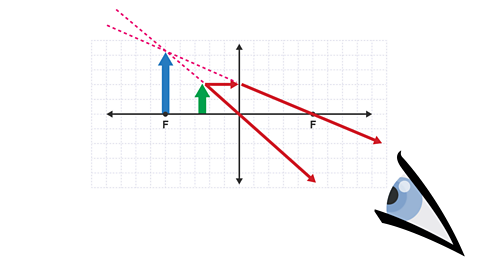
Image caption, 8. Only the person looking through the magnifying glass can see the image. The image cannot be projected onto a screen because it is a virtual image.
1 of 8
The table below summarises the nature of the images produced by a converging lens.
| Distance of object | Size | Orientation | Type | Position | Application |
|---|---|---|---|---|---|
| Further than 2F | Diminished | Inverted | Real | Between 2F and F | The eye or camera |
| 2F | Same size | Inverted | Real | 2F | |
| Between 2F and F | Enlarged | Inverted | Real | Further than 2F | Cinema projector |
| F | No image because the emerging rays are parallel to the axis | Searchlight. Or follow spot in the theatre | |||
| Closer than F | Enlarged | Upright | Virtual | Same side as object but further away | Magnifying glass |
How does the human eye work?
The normal, human eye forms a real, diminished, inverted image on the Retina The light-sensitive area on the back of the eye. Light must be focused on the retina in order to see clearly..
Most of the refractionProcess by which a wave changes speed and sometimes direction upon entering a denser or less dense medium, eg a light ray changes direction when refracted by a lens. occurs at the air – corneaThe transparent front part of the eye. boundary.
Light then enters the lens after passing through the pupilThe area at the front of the eye where light enters..
The converging (convex) lens provides the rest of the refraction necessary to focus the rays of light sharply on the light sensitive cells of the retina at the back of the eye.
The ciliary muscles change the shape and hence the focal length of the lens, allowing the eye to focus on both near and far objects.
What is the near point?
The closest distance from the unaided eye at which an object can be seen clearly is called the near point.
The near point is 25cm for a normal, adult eye.
What is the far point?
The furthest distance from the unaided eye at which an object can be seen clearly is called the far point.
The far point is taken to be infinity for a normal, adult eye.
What is range of vision?
The normal, adult, human, eye can see clearly objects at distances of 25cm from the eye to infinity.
This range is more limited for the very young or as we get older.
How are defects of vision corrected?
Long sight
A long-sighted person can see objects a long distance away (they have good long sight) but can’t see objects a short distance away. A long-sighted person can read writing on a whiteboard in a classroom clearly but cannot read print in a book or newspaper sharply.
Images of nearby objects (at 25cm from the eye) are formed behind the Retina The light-sensitive area on the back of the eye. Light must be focused on the retina in order to see clearly.. The image is blurred.
Long sight is due to the eyeball being too short, or the lens cannot be made thick enough by the ciliary muscles to focus the light rays on the retina. Long sight often occurs in older people as the ciliary muscles weaken with age
How to correct for long sight
Rays from a nearby object need to be converged more to form the image on the retina.
Long sight is corrected using a converging lens which starts to converge light rays from a nearby object before they enter the eye.
Converging (convex) lenses are used in reading glasses.
How to correct for short sight
A short-sighted person can see close objects clearly (they have good short sight), but they can’t see distant objects clearly.
A short-sighted person can read a book clearly but cannot read writing on a whiteboard in a classroom or a car number plate at distance.
The image of a distant object, say 2 m to 3 m from the eye, is formed just in front of the retina, causing it to appear blurred.
This defect is due to the eyeball being too long or the ciliary muscles cannot make the lens thin enough.
The full-scale diagram below shows a converging lens and an object. Each principal focus is marked with an F:
- Draw two rays to find the position of the image. Label the image I. Draw arrows on each ray to show its direction
- The magnification of an image, M, is defined by the equation: \(\frac{\text{height of image}}{\text{height of object}}\) Calculate the magnification of the image in your ray diagram. Show your working out clearly
- Is the image real or virtual? Explain your answer
- State an application for a lens in this way
- Height of object = 1.6 cm
- Height of image = 2.5 cm
- M = \(\frac{\text{height of image}}{\text{height of object}}\)
- M = \(\frac{\text{2.5 cm}}{\text{1.6 cm}}\)
- M = 1.6
- The magnification is 1.6
The image is real. Actual rays of light pass through the image. It can be projected on a screen
The image is real, inverted and enlarged. An application for a lens used in this way is a cinema projector
Test your knowledge
More on Unit 2: Light
Find out more by working through a topic
- count1 of 3
